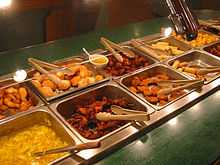Chinese restaurant

A Chinese restaurant is an establishment that serves Chinese cuisine outside China. Some have distinctive styles, as with American Chinese cuisine and Canadian Chinese cuisine. Most of them are in the Cantonese restaurant style. Chinese takeouts (United States and Canada) or Chinese takeaways (United Kingdom and Commonwealth) are also found either as components of eat-in establishments or as separate establishments, and serve a take out version of Chinese cuisine.
History
Chinese restaurants in the United States began during the California gold rush, which brought twenty to thirty thousand immigrants across from the Canton (Guangdong) region of China. By 1850, there were 5 restaurants in San Francisco. Soon after, significant amounts of food were being imported from China to America's west coast. The trend spread eastward, with the growth of the American railways, particularly to New York City.[1] There has additionally been a consequential component of Chinese emigration of illegal origin, most notably Fuzhou people from Fujian Province[2] and Wenzhounese from Zhejiang Province in Mainland China, specifically destined to work in Chinese restaurants in New York City, beginning in the 1980s. Quantification of the magnitude of this modality of emigration is imprecise and varies over time, but it appears to continue unabated on a significant basis. Adapting Chinese cooking techniques to local produce and tastes has led to the development of American Chinese cuisine.
In 1907, the first recorded Chinese restaurant in London, England was opened.[3] The rise in the number of Chinese restaurants in the UK only began after the Second World War, and has been attributed to returning service personnel.[4] In 2003, the first British Chinese restaurant achieved a Michelin star.[5] In the United Kingdom, the business employs a large percentage of Chinese immigrants (90% in 1985).[6] Opening a restaurant or takeway gave a relatively low capital cost entry for Chinese families into self-employment,[7] many takeaways served a pseudo-Chinese cuisine based around western tastes, and the limited cooking skills and experience of the shop owners.[7][8]
Chinese restaurant syndrome
In 1969, symptoms of "Chinese restaurant syndrome" were attributed to the flavour enhancer glutamate (commonly found in Chinese food) largely due to the widely cited article "Monosodium L-glutamate: its pharmacology and role in the Chinese Restaurant Syndrome".[9] However, no link has ever been established.[10]
See also
- Chinese takeout container
References
- ↑ Smith, Andrew F. (1 October 2009). Eating history: 30 turning points in the making of American cuisine. Columbia University Press. p. 47. ISBN 978-0-231-14092-8. Retrieved 22 June 2011.
- ↑ "Chinese Immigrants Chase Opportunity in America". Copyright 2011 NPR. Retrieved 2011-07-09.
- ↑ "Chinese diaspora in Britain" (PDF). British Museum. Retrieved 22 June 2011.
- ↑ "History of Chinese, Thai & other oriental restaurants in Britain". Retrieved 22 June 2011.
- ↑ Cahal Milmo (17 January 2003). "Chinese restaurant takes away Michelin star". The Independent (London). Retrieved 22 June 2011.
- ↑ Elizabeth Sinn (1998). The last half century of Chinese overseas. Hong Kong University Press. p. 429.
- ↑ 7.0 7.1 J.A.G. Roberts (2004). China to Chinatown: Chinese Food in the West. Reaktion Books. pp. 175–181.
- ↑ Wai Kam Yu (Joseph Rowntree Foundation) (2000). Chinese older people: a need for social inclusion in two communities. The Policy Press. pp. 6–7.
- ↑ Schaumburg H. H., Byck R., Gerstl R., Mashman J. H. (1969). "Monosodium L-glutamate: Its pharmacology and role in the Chinese restaurant syndrome.". Science 163 (3869): 826–828. doi:10.1126/science.163.3869.826. PMID 5764480.
- ↑ Geha RS, Beiser A, Ren C, et al. (April 2000). "Review of alleged reaction to monosodium glutamate and outcome of a multicenter double-blind placebo-controlled study". J. Nutr. 130 (4S Suppl): 1058S–62S. PMID 10736382.